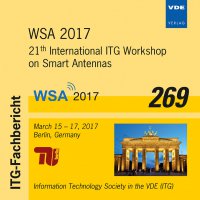Towards Spatially and Temporally Consistent Channel Modeling for Reliable V2X Communication
Konferenz: WSA 2017 - 21th International ITG Workshop on Smart Antennas
15.03.2017 - 17.03.2017 in Berlin, Deutschland
Tagungsband: WSA 2017
Seiten: 5Sprache: EnglischTyp: PDF
Persönliche VDE-Mitglieder erhalten auf diesen Artikel 10% Rabatt
Autoren:
Boban, Mate; Gong, Xitao; Manolakis, Konstantinos; Xu, Wen (Huawei Technologies Duesseldorf GmbH, German Research Center, Riesstr. 25c, 80992, Munich, Germany)
Inhalt:
Due to high mobility, dynamic surroundings, and antennas positioned on vehicles and in different locations, vehicle-to- everything (V2X) channel modeling presents a particular set of challenges, which we classify into three levels of variation. First, there exist "very slow" signal power variations - those created by long periods of blockage of line of sight by various static and mobile objects. Next, each of the resulting distinct states can be assigned different parameters, from shadow fading, to distributions and correlations of large scale parameters. Finally, even the small scale parameters will be different across states. In this paper, we analyze in detail the modeling of very slow signal variations as a cornerstone for spatially and temporally consistent vehicle-to-vehicle (V2V) channel modeling. After discussing existing deterministic and stochastic approaches for modeling the very slow signal variations, we propose a hybrid approach that combines the beneficial aspects of deterministic and stochastic models. We investigate how modeling of very slow variations impacts the path loss over time and space and evaluate its impact on the achievable spectral efficiency. We show that path loss and spectral efficiency results generated by different models differ considerably, both in terms of the results for a single link over time/space as well as in terms of the overall statistics. Finally, we propose a modeling approach for very slow signal variations between multiple collocated or nearby V2V links (e.g., links between multiple antennas on two vehicles) and describe how correlation properties in their line of sight blockage are included into the overall channel model.


